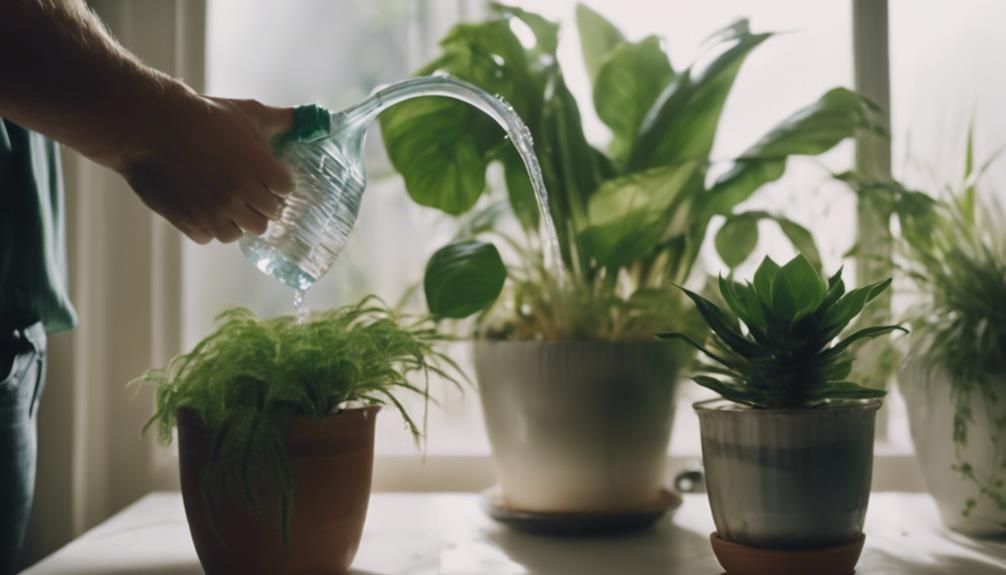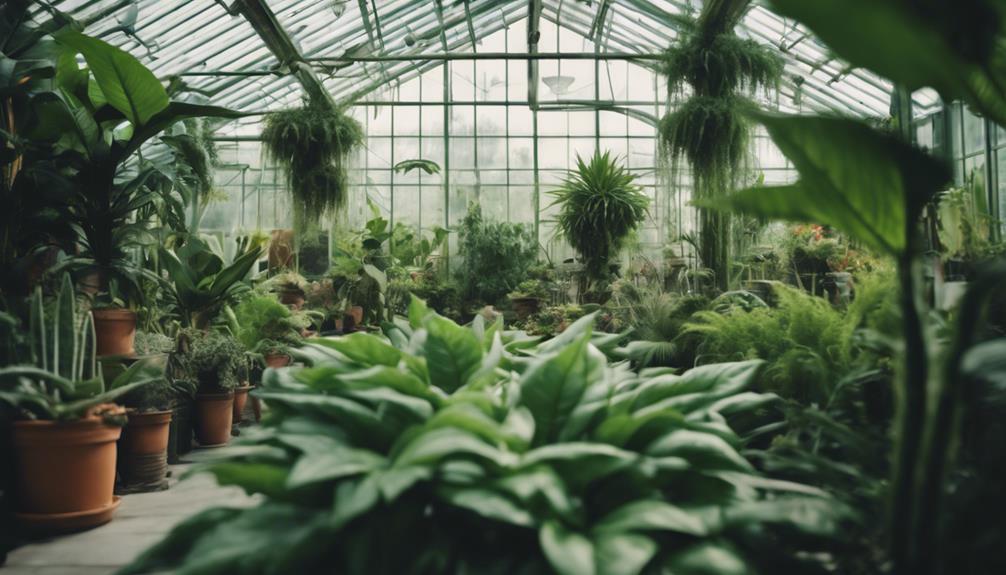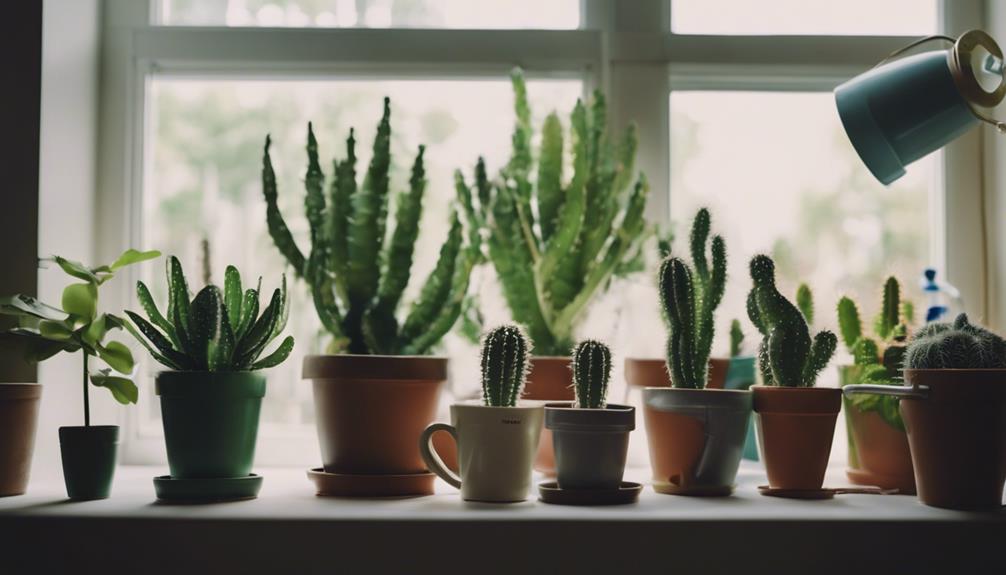Indoor spaces come alive with the presence of large indoor plants such as Cacti, Succulents, Ponytail Palm, Croton, Hoya, Amaryllis, and Ficus. Cacti and Succulents need proper light and drainage to thrive, whether in bright sunlight or in dimly lit corners. The Ponytail Palm is low-maintenance and can thrive in both sunny and low-light areas, adding beauty with its flower stalks. Croton’s vibrant leaves require a balance of brightness and humidity, while Hoya’s glossy leaves are perfect for hanging baskets in different lighting conditions. Amaryllis blooms with colorful flowers, needing attention to both light and watering to shine. Ficus, known for its air-purifying qualities, enhances any space beautifully. Explore more greenery options for a refreshing indoor environment.
Key Takeaways
- Consider low-maintenance options like Ponytail Palm and succulents for various lighting conditions.
- Opt for vibrant Croton Plant or Amaryllis for colorful leaves and striking blooms in bright light.
- Hoya Plant is versatile, thrives in bright to low light, and is ideal for hanging baskets.
- Ensure proper drainage for cacti and succulents to prevent root rot.
- Choose plants like Amaryllis that require regular watering and well-draining soil for indoor beauty.
Cacti and Succulents
When caring for cacti and succulents, it's important to provide them with the right amount of light and proper drainage. These indoor plants thrive in bright light, making them perfect for sunlit areas in your home.
However, if you have limited natural light, don't fret! Succulents can also adapt to lower light conditions, but be mindful to introduce them gradually to prevent sunburn.
To keep your cacti and succulents healthy, it's essential to allow the soil to dry out between waterings. Overwatering can lead to root rot, a common issue with these plants.
Make sure that your pots have adequate drainage holes to prevent waterlogged roots, especially if you're keeping them indoors.
Ponytail Palm

Moving on from discussing cacti and succulents, let's explore the low-maintenance Ponytail Palm, a striking indoor plant option. Here are some interesting facts about the Ponytail Palm:
- Thrives in Various Lighting Conditions: The Ponytail Palm can bask in full sun, making it a perfect choice for sunny spots in your home. Additionally, it can also tolerate lower light conditions, making it versatile for different indoor environments.
- Requires Minimal Attention: With its low-maintenance nature, the Ponytail Palm is a great choice for busy plant enthusiasts. Its watering needs are similar to succulents, meaning infrequent watering is all it requires to thrive.
- Adds Visual Appeal: When grown outdoors, the Ponytail Palm may surprise you with flower stalks, enhancing its already captivating appearance.
Croton Plant

Croton plants are known for their vibrant, colorful leaves that can add a pop of brightness to any indoor space.
To care for these beauties, it's essential to provide them with plenty of bright light and humidity while being mindful not to overwater or underwater them.
Maintaining the right balance of soil moisture is key to keeping your croton plant happy and thriving.
Colorful Leaves
Why do Croton plants stand out among indoor plant options?
Croton plants catch the eye with their vibrant foliage, making them a popular choice for indoor spaces seeking a splash of color. Here are three reasons why these plants are a fantastic addition to your indoor garden:
- Diverse Color Palette:
Croton plants boast a stunning array of colors, including rich greens, bright yellows, fiery oranges, and deep reds. Their leaves come in various shapes and sizes, creating a visually enchanting display in any room.
- Thrives in Indirect Light:
These plants thrive in bright, indirect light, making them perfect for indoor areas with good natural lighting. Placing them near a window where they can soak up the sunlight without direct exposure ensures their colorful leaves stay vibrant.
- Adds Life to Indoor Spaces:
With their striking appearance and unique leaf patterns, Croton plants breathe life into indoor environments. Their colorful foliage can transform a dull room into a lively, visually appealing space.
Care Tips
When caring for Croton plants, ensuring they receive ample bright light and high humidity levels indoors is important for their thriving. These vibrant plants aren't fans of low light conditions; they crave that sunshine to show off their colorful leaves. However, it's important to strike a balance with the light intensity, as too much direct sunlight can scorch their delicate foliage.
In addition to light, maintaining proper soil moisture levels is key to keeping your Croton healthy. Overwatering or underwatering can lead to leaf drop, so it's necessary to water them consistently, ensuring the soil is moist but not waterlogged.
These plants prefer their soil to be on the damper side, but be cautious of letting it dry out completely.
Hoya Plant
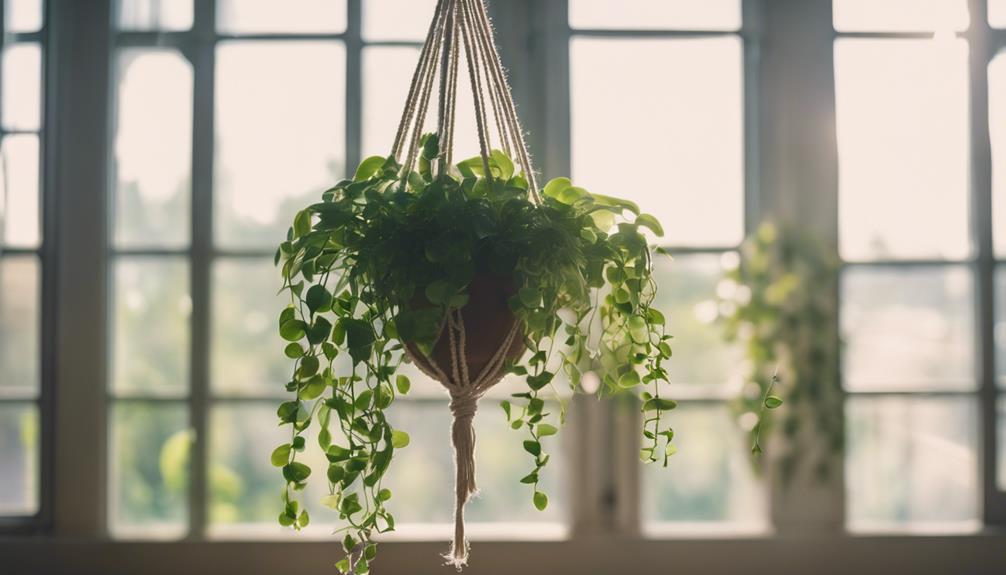
In bright, indirect light, Hoya plants thrive, making them a great option for indoor spaces near windows. These plants have waxy leaves that help retain moisture, making them adaptable to various conditions both indoors and outdoors.
Here are a few reasons why you might want to contemplate adding a Hoya plant to your indoor space:
- Low-light conditions: Hoya plants can tolerate lower light levels, making them suitable for areas with less natural light.
- Waxy leaves: The glossy, waxy texture of Hoya leaves not only adds visual appeal but also helps the plant retain moisture effectively.
- Ideal for hanging baskets: With their cascading growth habit, Hoyas look stunning in hanging baskets, adding a touch of greenery to any room.
Whether you place them in hanging baskets or near windows, Hoya plants are versatile, low-maintenance options that can elevate the aesthetic of your indoor spaces.
Amaryllis

Amaryllis plants, thriving in bright, indirect light, are excellent choices for indoor spaces located near windows. These tropical plants add a touch of vibrancy to any room with their striking blooms. They're relatively low maintenance, making them perfect for both experienced and novice plant enthusiasts.
To keep your Amaryllis healthy and blooming, make sure they receive adequate sunlight and regular watering. During warmer seasons, consider moving them outdoors to encourage peak growth.
Proper care is essential for the well-being of Amaryllis plants. Use well-draining soil to prevent waterlogging, which can lead to root rot. Additionally, occasional fertilization can help boost their growth and blooming potential.
With their stunning flowers and adaptability to indoor environments, Amaryllis plants are a popular choice for those looking to bring a bit of the outdoors inside. Whether placed in a living room, bedroom, or office, these plants are sure to brighten up any space.
Ficus Plant
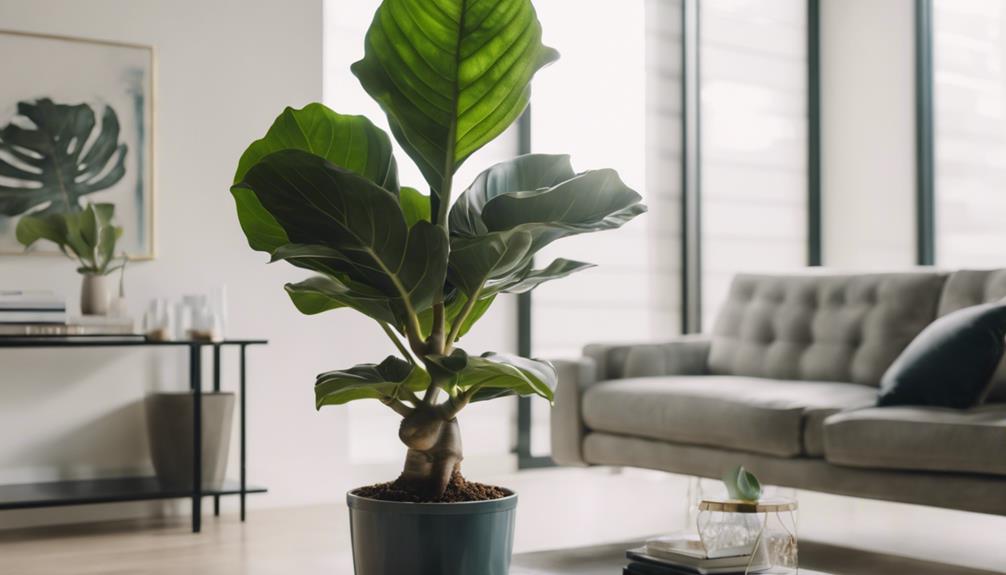
Let's explore the versatile Ficus Plant, a great option for indoor greenery. Ficus plants, such as the popular fiddle leaf figs, are excellent choices for indoor spaces.
Here are three key points to keep in mind:
- Adaptable to Low Light: Ficus plants can thrive in indoor environments with low light conditions, making them ideal for rooms with minimal natural sunlight.
- Indoor Versatility: Whether placed indoors or outdoors, ficus plants can adapt well to different settings, offering flexibility for your indoor garden design.
- Bright Corner Friend: If outdoor placement isn't feasible, bright indoor corners can serve as suitable spots for your ficus plant to grow and flourish.
Ficus trees can bring a touch of nature into your home, but remember that they require consistent care and monitoring to maintain their health and growth. By understanding their needs and providing the right environment, you can enjoy the beauty of ficus plants indoors.
Frequently Asked Questions
Can I Bring My Indoor Plants Outside?
Yes, you can bring indoor plants outside, but it's crucial to do so gradually. Start by acclimating them to outdoor conditions to prevent shock and stress.
Check nighttime temperatures and safeguard plants from harsh elements like strong winds and heavy rain. Gradually increase sun exposure to prevent sunburn, and make sure outdoor pots have proper drainage to avoid waterlogging and root rot.
Moving slowly will help your plants thrive in their new environment.
Can I Put My Monstera Plant Outside in the Summer?
Yes, you can place your Monstera plant outside in the summer. Make sure it's placed in a shaded or partially shaded spot to prevent leaf burn. Mimic its natural rainforest habitat with indirect sunlight.
Watch for signs of stress like yellowing leaves, indicating too much direct sun. Provide a stable environment with consistent temperatures and shield from strong winds.
Water adequately to prevent dehydration and promote healthy growth during its outdoor stay.
Which Houseplants Like to Go Outside in Summer?
Yes, some houseplants thrive outdoors in the summer. Ponytail palms, crotons, and Hoya plants can be moved outside for best growth.
Amaryllis plants also enjoy outdoor placement in the summer. Ficus trees, including fiddle leaf figs, can adapt to outdoor conditions but may experience leaf drop.
Snake plants, like sansevieria, are adaptable and can thrive outdoors in shady areas with proper care.
What to Do Before Bringing Outdoor Plants Inside?
Before bringing outdoor plants inside, we trim and clean them up, removing dead or leggy growth for healthier indoor growth.
We thoroughly check for pests in the soil, on leaves, and in pot drainage holes. Repotting may be necessary if plants have outgrown their pots.
If not repotting, we refresh the soil with nutrients.
What are the Best Indoor Plants for Watering?
When it comes to choosing indoor plants that are easy to maintain, it’s important to consider their watering needs. Some of the best indoor plants for watering tips for plants include snake plants, pothos, peace lilies, and spider plants. These plants require minimal watering and are great for beginners.
Conclusion
To sum up, bringing the outdoors in with these great big indoor plant options can truly transform your living space into a green oasis.
Just imagine the calming presence of a ponytail palm or the vibrant colors of a croton plant brightening up your home.
With the right care and attention, these plants can thrive indoors, bringing a touch of nature to your everyday life.
So go ahead, pick your favorite plant and let the beauty and tranquility of nature fill your home.



